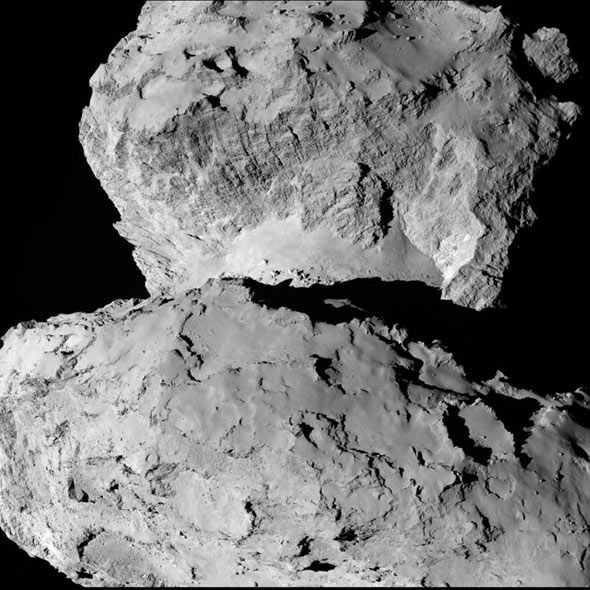Create a free profile to get unlimited access to exclusive videos, sweepstakes, and more!
FANTASTIC Close-Up of a Comet From Rosetta ... and Evidence of a Landslide

The European Space Agency has released close-up images of the comet 67/P Chuyurmov-Gerasimenko taken by the Rosetta spacecraft when it was only 104 kilometers from the nucleus, and they're beauts!
This was taken through Rosetta’s main OSIRIS camera (a second image, available here, was taken 17 minutes later). Most of the images we’ve seen have been from the navigation camera, and lower resolution—I have a gallery of images from Rosetta in an earlier post. But in this one, wow! There’s a lot to see.
Remember, the comet nucleus has two main parts to it, a large, flattish “body” and a smaller, rounder “head” (it helps to think of it as a rubber ducky shape). They’re connected by a narrow neck, which we knew from earlier images was a bit brighter, more reflective.
In this image, we’re looking along the long axis of the body (bottom), so it looks foreshortened. This angle gives us a good look at the head (top) and neck. The head looks like there’s a sheer cliff there (about a kilometer high), and at the neck you can see brighter material piled up, with boulders and other rubble on top.
I’m going to do something I very rarely do, which is indulge myself in a little speculation. I am not a comet specialist, so I may be way off here. But this is too much fun to resist, and if I’m wrong—and an expert does come out and talk about this—I’ll let you know.
Think about the shape of the comet, and its gravity. If it were just a single, big lump, standing on the surface you’d feel a (very gentle) pull from gravity down, toward the center.
But it’s not simple; it has two such lumps. If they were the same size and the same shape, then if you were in between them you’d feel an equal pull from each, in opposite directions. There would be less gravity at that spot. As you moved closer to one lump or the other, you’d feel a gradually increasing pull from gravity from that lump. Making things worse, the body lump is bigger, so it actually has more gravity. Just walking around the comet nucleus would be quite a bizarre trip, with your weight constantly changing.
Also, comets are fragile. They’re made of rock and gravel and dust help together by ice, and very weakly by their own gravity. They suffer small collisions over billions of years, and it wouldn’t surprise me if they’re riddled with cracks throughout. 67/P orbits the Sun on an ellipse, and when it gets closer some of that ice turns into a gas and escapes (we’re already seeing that happening now, in fact).
We sometimes see an event in comets called “calving,” where a large chunk of the solid nucleus separates off and flies away into space, together with debris. I wonder very much if we’re seeing the aftermath of such an event here.
I’d guess that ice warmed up, turned into gas, and leaked out through a crack in the head. When enough escaped, the rock was weakened, and the pressure exerted by the gas sheared off a huge chunk. That may have flown off into space, but the weird gravity of the region pulled some the debris into the neck region in a massive landslide, where it piled up.
The surface gravity on the comet is less than a thousandth that of Earth. Friction would play a large role, which is why I suspect the stuff piled up in the neck. Debris might want to flow onto one of the lobes or the other, but the pull of gravity is so weak, and the resistance due to friction so high, that flow was restricted.
Again, I’m guessing here, so don’t take this to heart. But images like this one are exactly what scientists wait their whole lives to see. Examining them is fun, and speculating is the start of inquiry.
But it’s not the end. Without more evidence, speculation is just that: a wild guess. But the beauty here is that we’ll be getting far, far more data from Rosetta. It’ll orbit the comet for more than a year, and will deploy the Philae lander in November. We’ll be getting a lot more images—some from a mere few kilometers away!—and eyes on the ground as well. I may be speculating now, but I have to hope that in a few months, we’ll know.


























